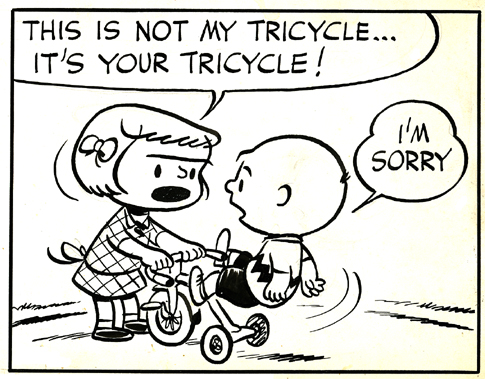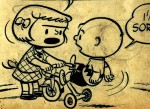Ch-Ch-Ch-Changes
on October 25, 2011

Peanuts Daily 9-28-51
Going through the process of developing a panel for a strip can be hard work. We make changes, scratch what we start, and try again. Here’s a close-up of a Charles Schulz Peanuts daily from September 28, 1951, within its first year. Notice how Schulz redraws both Charlie Brown and Patty in different poses until he found just what he was looking for. Click on image below for a larger version.
I do my drawings on separate paper and then trace the finalized drawing onto the bristol board to ink, but often times I redraw right on the paper. If there’s a lot of drawing it can be hard to erase. Schulz’s pencil lines are faint, but I’m glad he didn’t erase them out of existence!

Complete Peanuts daily 9-28-51


Discussion (31) ¬
I got the chance to go to the Schulz museum this summer, and saw a lot of his process stuff. So inspiring to see even HE had to deal with a lot of the challenges I struggle with. Also inspiring to get an idea of the shear volume of work he did to become the best.
That would be an awesome experience. I’ve heard they have his desk and the room he worked exactly as he left it. I would love to see that.
I’ll be honest, I was on a tour, and had no idea about his drawing desk. I took a wrong turn when everyone went out on the balcony, and I wandered into his drawing area… and I got really emotional. I actually started to tear up a bit just being in the presence of that space. It was pretty amazing. I’ve never experienced anything like that before. I highly recommend it. The Walt Disney Family museum isn’t too far from there either. It’s equally fantastic!
On a side note: I had such a good time talking to the little old ladies that run the place, that one of them gave me and my sister free tickets for ice skating at the ‘warm puppy’ next door. It was wonderful… for about 30 seconds… till I completely wiped out and had the wind knocked out of me. I hobbled off and went for a hot dog. Lol. I am not meant for ice skates.
Well look on the bright side, Will, at least you’re brilliant with a brush, lol.
Wow, that’s great. You’re the first person to ever tell me what that tour is like. Sounds like it was a real thrill.
There’s this this mural on one of the walls, its covered in little tiles made up of the strips, it took nearly 10,000 tiles to fill the wall. And they all blend together to make a picture. ITs really humbling to see all that work in one image. I was told he did over 18,000 strips in his career. That really put my career in perspective for me, and made me get down to “real” work, instead of living in a fantasy world.
I think most non-artists think that cartooning is fun and no work at all. If they could imagine 18,000 comic strips piled up in a stack they might reconsider. The work IS hard, and it never stops. Most cartoonists I know are addicted to drawing, in the best sense of the word. It’s a constant battle of deadlines, fighting your inner critic and physical stamina, but man what a great gig!
Ain’t that the truth! I’ve been at this 15 years and I am only starting to feel like I can draw whatever I want. Heh. Now the goal is to do something with that.
As much as I’ve had fun doing illustrations and graphic design, there’s something about sequential art that pulls me in. I guess all of us webcomickers have that in common. Not necessarily telling stories (which is fine), but giving the audience something to put together in their minds, whether its funny, dramatic, or whatever. That’s what I think is the draw for me. It’s interesting how you say it’s taken you 15 years to just get to the point where you can begin doing what you want. All our fellow online cartoonists seem to be following that premise as well. It’s hard work, but you can’t settle. There’s always room for improvement.
Early on, for me, there was such a struggle just to draw a face, or pull of an expression, let alone give a character personality. Now, after years of drawing from life, it feels effortless. Its a fun place to be, and didnt think I’d ever be able to say that.
I think what I love so much about sequential art, is that I can imagine all of these worlds and experiences, and invite someone into that place to experience it too. I always did that as a kid, I just didnt know it could be done as a job, until much, much later on. I just love that you can, for just a few moments, take someone to a whole other place, is just incredible.
I agree, Will. As much as I love animation, I think comic strips are the superior art form. Most of the time the work is a pure expression by a single creator. That cartoonist is the writer, the artist, the letterer, the colorist, the editor, the visionary. I remember asking Will Eisner once if he dreamed in color and without batting an eye he answered, “I dream in panels.”
The dedication you’ve given to drawing from life really shows in your work. If anyone were to ask me how they can improve their figure work, I’d tell them to follow your lead and take their sketchpad and pencil out to a public place and draw what they see. I’ve done a lot of figure drawing and I can vouch it comes in handy, even if you’re drawing the simplest cartoon.
I love these kinds of post! Thank you for taking the time to share this with us.
You’re welcome, Hjortur. I’m glad you like it. I get a thrill out of seeing this stuff, too.
I love the look of the original CB
Man, I do too. They seemed to have more facial expressions in the original style. Schulz just sort of whittled away at them until they became almost like gestures. Still, even his scribbly style works for me.
i love these comic history type posts. entertaining and informative lil’ reads.
I’m glad you do, Colm. I enjoy putting them together. There’s so much we can absorb from this stuff.
These posts are always so interesting & great to learn techniques from. Shouldn’t she be saying “This is not your tricycle it’s my tricycle”? It seems the wrong way around to me.
It makes sense when you read the whole strip. I’m going to add it to the bottom of the post.
That’s pretty neat! I’ve seen some originals of later strips (1970’s). The thing that really struck me about those, had been the absence of white out or corrections of any kind.
Peanuts was always a huge influence on me. I have to say, this particular era of Peanuts (1950 – 1953) is my favorite with regard to Schulz’s drawing style, and I’ve tried to emulate it at times. Personally, as to the strip overall, I always felt the strip was at it’s zenith from 71-74. In 1975, in the book “Peanuts Jubilee” (basically, the halfway point) Schulz said that his favorite year of the strip was 1968.
I’ve seen a lot of Peanuts originals. The earlier ones seem to have more pencil under drawing, Schulz was learning how to draw the characters and getting his bearings on the strip. The later ones have very little, almost gesturing lines, at that point I think he was using them for position only and doing most of the work with his pen. I like his early 50s version too.
It must be great to be able to see these original works! Cartooning is such a neat art form! And I hope you keep posting these old strips.
I’m glad you like it. I’ll definitely be posting more.
Don’t forget, kids: Patty and Peppermint Patty are two different characters!
Also, don’t forget: Peppermint Patty was not a lesbian. She had a mad crush on Ol’ Chuck.
Well, look who it is…the Patty Patrol! Thanks for the recap, Dada sir.
I love deep research posts like these. It’s great seeing how how our idols created their respective strips. 😀
Honestly George, I had no idea how true those words were until I posted this stuff. Seems to be a lot of people who dig seeing these kinds of posts. I’m glad you like them! I’ll try to do more down the line.
Great absurdist strip! His early ones were great. He was definitely working his heart out developing his style. Later on he would almost draw them freehand. Also the photo-plating of the strips for newspapers allowed for less erasing, since it only picked up the darkest blacks. The corrections were then done by the printers who would ‘retouch’ the strips sometimes. These days we get to do all that ourselves! 🙂
Oh yes, the old Photoshop eraser. Nothin’ like it! From what I’ve seen on later Schulz strips, there was almost like a shorthand going on. Very limited linework, almost just for position. The early dailies have so much more pencil showing.